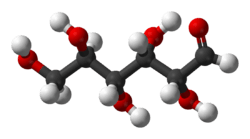Fehling's solution

Fehling's solution is a chemical test used to differentiate between water-soluble carbohydrate and ketone functional groups, and as a test for monosaccharides. The test was developed by German chemist Hermann von Fehling in 1849.[1]
Laboratory preparation
Fehling's is always prepared fresh in the laboratory. It is made initially as two separate solutions, known as Fehling's A and Fehling's B. Fehling's A is a blue aqueous solution of copper(II) sulfate, while Fehling's B is a clear and colorless solution of aqueous potassium sodium tartrate (also known as Rochelle salt) and a strong alkali (commonly sodium hydroxide).
Equal volumes of the two mixtures are mixed to get the final Fehling's solution, which is a deep blue colour. In this final mixture, aqueous tartrate ions from the dissolved Rochelle salt chelate to Cu2+ (aq) ions from the dissolved copper(II) sulfate, as bidentate ligands giving the bistartratocuprate(II)4- complex as shown below. The tartarate ions, by complexing copper prevent the formation of Cu(OH)2 from the reaction of CuSO4.2H2O and NaOH present in the solution.
Fehling's can be used to determine whether a carbonyl-containing compound is an aldehyde or a ketone. The bistartratocuprate(II) complex in Fehling's solution is an oxidizing agent and the active reagent in the test. The compound to be tested is added to the Fehling's solution and the mixture is heated. Aldehydes are oxidized, giving a positive result, but ketones do not react, unless they are alpha-hydroxy-ketones. The bistartratocuprate(II) complex oxidizes the aldehyde to a carboxylate anion, and in the process the copper(II) ions of the complex are reduced to copper(I) ions. Red copper(I) oxide then precipitates out of the reaction mixture, which indicates a positive result i.e. that redox has taken place (this is the same positive result as with Benedict's solution). A negative result is the absence of the red precipitate; it is important to note that Fehling's will not work with aromatic aldehydes; in this case Tollens' reagent should be used.
Fehling's test can be used as a generic test for monosaccharides. It will give a positive result for aldose monosaccharides (due to the oxidisable aldehyde group) but also for ketose monosaccharides, as they are converted to aldoses by the base in the reagent, and then give a positive result.[2] For this reason, Fehling's reagent is sometimes referred to as a general test for monosaccharides.
Fehling's can be used to screen for glucose in urine, thus detecting diabetes. Another use is in the breakdown of starch to convert it to glucose syrup and maltodextrins in order to measure the amount of reducing sugar, thus revealing the dextrose equivalent (DE) of the starch sugar.
Formic acid (HCOOH - methanoic acid) also gives a positive Fehling's test result, as it does with Tollens' test and Benedict's test also. This is because it is readily oxidizable to carbon dioxide and water.
Safety
Sodium hydroxide is caustic at high concentrations and precautions should be taken as such not to come into direct contact with it. Copper(II) sulfate is also toxic if ingested.[2]
Images
-

The aldehyde form of glucose
-

[CuII(tartrate)2]4− complex
-
-oxide-3D-polyhedra.png)
Crystal structure of the copper(I) oxide precipitate
-
Fehling test, left side negative, right side positive
See also
References
- ↑ H. Fehling (1849). "Die quantitative Bestimmung von Zucker und Stärkmehl mittelst Kupfervitriol". Annalen der Chemie und Pharmacie 72 (1): 106–113. doi:10.1002/jlac.18490720112.
- ↑ 2.0 2.1 Fehling's Test for Reducing Sugars
External links
-
 "Fehling's Solution". Collier's New Encyclopedia. 1921.
"Fehling's Solution". Collier's New Encyclopedia. 1921.

